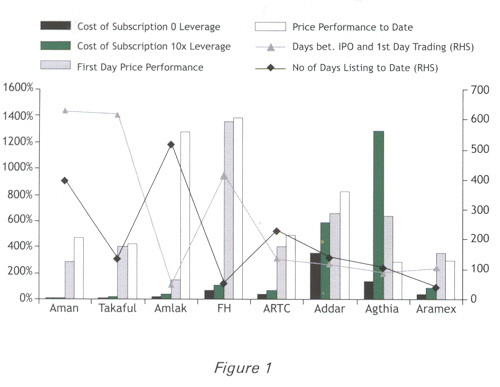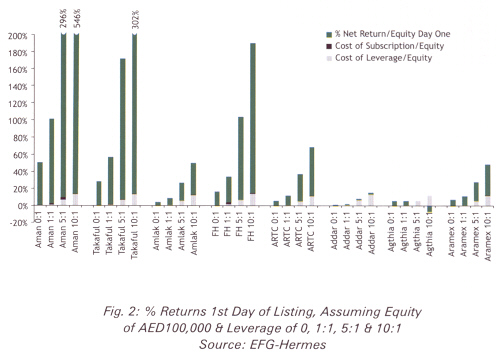|
A.
Market Overview
The UAE equity
markets are a fairly recent development. Until 2000,
stocks were traded over an un-regulated over-the-counter
market. In May and November 2000, the Dubai Financial
Market (DFM) and
Abu Dhabi Securities Market (ADSM) began trading.
Existing over-the counter stocks were gradually
transitioned to the formal exchanges. Stock market
performance has been nothing short of spectacular and
value traded has increased substantially.
B.
History of IPOs
The first IPO on
an organized exchange, Dubai Islamic Insurance and
Re-Insurance ("Aman"), occurred in October 2002. Since
that time, the pace and size of IPOs has increased
substantially and is expected to increase further as can
be seen from Figure 3, despite recent measures taken by
the authorities to slow the flow of new companies coming
to market. The amount to be raised at IPO in 2H2005 that
has been publicly disclosed amounts to 2% respectively
of the existing combined estimated free float market
capitalization of the DFM and ADSM.
As the stock
market has risen and IPOs have performed, so the level
of interest on the part ofretail investors has increased
substantially. This behavior is typical of a bull market
environment.
As issues have
become progressively more over-subscribed, so investors
have borrowed to improve their allocation of shares. As
more investors have borrowed, so the level of
oversubscription has risen, forcing investors into a
vicious circle of borrowing even more so as to obtain a
decent absolute allocation.
Three benchmark
IPOs have been Addar, Agthia and Aabar. After the Addar
IPO, which saw oversubscription of 450x, the UAE
authorities imposed limits on the maximum permissible
leverage accorded to investors. Agthia, which came after
Addar, was the first IPO to guarantee a minimum
allocation to retail investors. As a result, the number
of subscribers rose significantly and oversubscription
declined significantly. Aabar was important because the
return to high levels of oversubscription led the
authorities to impose quantitative limits (i.e. a
maximum AED amount to be lent per bank) on margin
lending at banks.
C.
Cost of Entry into IPOs
The need to
borrow so as to obtain a reasonable allocation at IPO
imposes a high cost on investors, especially given that
only a very small fraction of the amount being
subscribed to is likely to be allocated. We have
estimated this cost for each of the IPOs that has been
carried out to date.
i) Our
assumptions are as follows: i) An equity capital amount
of AED100,000. It is important to specify this as later
offerings guaranteed a minimum allocation to retail
investors.
ii) Cost of bank
funding of 5.5% per annum and a loan arrangement fee of
1.0%. Here it is important to bear in mind that as there
is more than one bank at which investors can subscribe
to shares and borrow and competition between banks has
meant that interest rates have tended to decline with
loan size in later IPOs.
iii) An
opportunity cost for the equity portion of approximately
1.5% reflecting the interest foregone on a time deposit.
iv) Subscription
at the end of the subscription period rather than at the
beginning, thereby minimizing both the opportunity cost
and the interest due on any loan.
We calculate the
estimated cost as a percentage of the value of the
eventual allocation given the above assumptions.
D.
Returns on IPOs
While the cost
of entry is high, this has been more than compensated in
almost all cases by the performance of the stocks from
the first day of issue onwards, as is illustrated in
Figure 1.

While
subscribers to the earlier IPOs had to wait almost two
years from the end of the subscription period to
listing, subscribers to the four most recent IPOs have
had to wait between 91 and 134 days between the close of
the IPO and the listing of their shares. An active grey
market has provided liquidity in the interim.
E.
Valuation of companies coming to IPO
Companies
issuing their shares on the exchange have to comply with
regulations of the Emirates Securities and Commodities
Authority (ESCA). There are currently two ways for the
shareholders of an existing company ("Old Co") to bring
it to market:
i) They can
establish a new Public Joint Stock Company (PJSC or "New
Co"). New Co can then acquire the assets of Old Co prior
to the IPO with New Co stock as consideration. A
valuation committee is appointed by the Ministry of
Economics and Planning to compare the valuation of the
company and goodwill relative to Book Value
historically. The "un-written" rule is that valuation
should not exceed 1.5x book value.
ii) They can
establish a New Co. that would acquire the LLC for cash
post-IPO. The ministry requires a report to validate the
valuation of "Old Co" at acquisition. There is no
regulation/restriction regarding valuation under this
structure.
Furthermore,
under the current regulations, the shares in the New Co
must be offered to investors at par, and a minimum of
55% of paid in capital should be offered at the IPO.
However, according to the new law which is expected to
be implemented at some point in 2H2005, companies will
no longer be obliged i) to offer a minimum of 55% of
paid-in capital at IPO or ii) to create a new company
for the purpose of listing.
Part of the
reason that there has been such intense interest in IPOs
is that they have been priced, on the whole, at
valuations that are markedly below the prevailing market
valuations, as is illustrated in Figure 8. Furthermore,
there seems to have been a difference between the
valuations of private sector companies and public sector
companies being brought to market, with public companies
being offered at lower multiples. Lower than market
valuations for IPOs have helped to fuel jumps in share
prices on the first day of trading and sustain them
thereafter, as was illustrated in Figure 2.

F.
Sensitivity of IPO Returns
In this section,
we examine the sensitivity of IPO returns to leverage
employed by investors. We find that there have been
increasing returns to utilizing higher levels of
leverage, especially before the Agthia offering, when
offerings did not provide a minimum allocation to retail
investors. Minimum allocations to retail investors have
reduced the proportionate allocation to investors
subscribing to more than the minimum amount.
G.
Inefficiencies of the Current System
As we discussed
earlier, the fact that a UAE company has to list at a “
reasonable” valuation has led to tremendous demand and
oversubscription. The pro-ration of subscriptions has
led to an incentive to over-subscribe and with the banks
being more than willing to lend, a competitive dynamic
among investors has led to increasing and ultimately
massive levels of loanfinanced oversubscription. As a
result, a portion of the discount to market value has
gone to the banks as arrangement fees, interest and zero
cost deposits (although, as a result of competition,
banks have started to pay interest). The impact has been
significant on banks' financial performance with a
tremendous rise in non-interest income.
Ultimately, the
current IPO system is inefficient with companies unable
to price their shares in line with the market and
investors having to pay high transaction costs so as to
obtain a reasonable allocation. The authorities are in
the process of tackling both inefficiencies, first by
not imposing onerous terms on issuers and second by
imposing limits on leverage provided by banks so as to
reduce subscription costs for investors.
| 